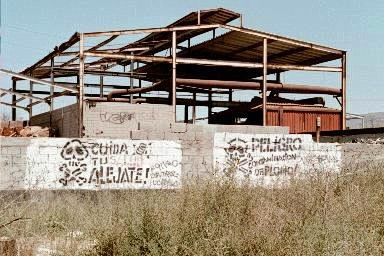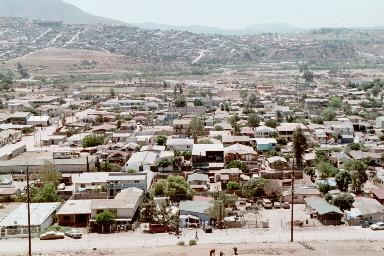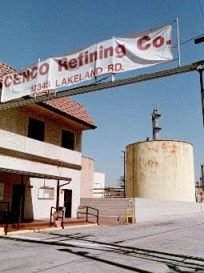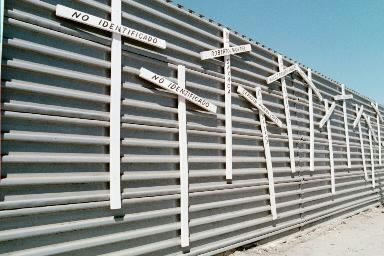|
Globalization Along Our Border & In Our Backyard
The following presentation was given in November 2000 as a Cal
State Fullerton Geography Department Brown Bag Lecture.
|
 I have recently gone on a couple of "Reality Tours" with a human
rights organization called Global Exchange, and I was so amazed at the
things that I saw and heard that so I wanted to bring some of it back
and share it with you.
I have recently gone on a couple of "Reality Tours" with a human
rights organization called Global Exchange, and I was so amazed at the
things that I saw and heard that so I wanted to bring some of it back
and share it with you.
The trip that
I recently went on was to the US-Mexico border where we spent four days looking
at various human rights issues that are becoming especially critical with
the increasing globalization of our border. We stayed in Tijuana,
and during our stay we visited factories ("maquiladoras"), talked to local
activists, heard about environmental problems in the area, and looked at
illegal immigration and the current US program to curb the flow. And
all that we did was really focused on globalization and how the increasing
interaction between our nations is impacting Mexicans who live along our
shared border.
We often
hear about the awesome forces of globalization, and we tend to imagine this
'globalization' thing swarming all around us, causing those 'inevitable'
changes that we so frequently hear about. Yet the more I read about
it and think about it, the less inevitable much of it appears. In fact, there
is nothing inevitable about much of the globalization that is sweeping
across the world. Instead, many such changes are the result of policies
and decisions made by actual human beings. It may seem a silly
point, but it is an important kind of premise to what I am going to talk
about today and what the whole trip was about. When we talk about the human
impacts of globalization, it is important to see the people impacted,
of course, but also see that this isn't some 'natural phenomenon.'
And because a lot of what we call globalization is the result of decisions
by people, not magical, mysterious forces,
those decisions can be questioned--they should be questioned--and reviewed
and assessed as to whether it’s a good system (dare I say "fair"),
and what can be changed and improved.
Of course,
there are many well-known benefits of globalization, and, likewise,
the notion that there are also negatives of globalization is widely acknowledged.
Indeed, most people do acknowledge that there will be some losers in the
"globalization" game. We have all heard statistics, such as...
|
- In Latin
America there are 240 million human beings without the necessities of life,
and this when the region is richer and more stable than ever, and
during a time in which free trade and other hallmarks of globalization
are more present than ever.
- Back
in 1995, Oxfam had economists forecast the benefits to various regions of
the World Trade Organization by 2002. This group of experts concluded
that the European Union will have gained $80 billion from trade liberalization,
while Africa will have lost $2.6 billion.
|
.
So there are clearly
winners and losers in the globalization game, and I am going to talk
about some of the 'losers' today. But one last thought before I do... Many
economists are saying that globalization will, among other things,
extend the Third World model to industrialized countries, creating
a society that is two-tiered-- with a small sector of extreme wealth &
privilege on one end and a large sector of the masses on the other end (the
'superfluous' people). What? The losers of globalization aren't
just 'out there'? They are here? That is something to think about!
There are certainly statistics that seem to support this trend:
.
- According
to a recent Census Bureau report, there has been a 50% increase in the working
poor (people who have jobs but are still below the poverty level).
- The
Lancet , the British medical journal (which is the most prestigious
medical journal in the world) recently published a study which found that
40% of children in New York City live below poverty level, and suffer from
malnutrition and other conditions that accompany poverty.
- The
New England Journal of Medicine (the American answer to the Lancet) recently
studied the mortality rates of black males in Harlem and found that they
average around the same as in Bangladesh!
- Business
Week reports "The gap between high- and low-income families has widened steadily
since about 1980, hitting a new high every year since 1985."
- Lastly,
U.S. Secretary of Labor Robert Reich adds "We have the most unequal distribution
of income of any industrial nation in the world ... we can't be a prosperous
or stable society with a huge gap between the very rich & everyone else."
|
I mention all these
statistics because when I have discussed this notion with people recently,
I generally get a response similar to "No, I don’t believe that."
And maybe these economists who are projecting a
growing income gap in the United States are entirely wrong? There
are statistics to support it, yet we all know that statistics
can be found to support anything. Regardless, I think it is interesting
to consider, and so I have decided to include examples in the US when we
talk about negative impacts of globalization on Mexicans who live along our
border. Because chances are--it's not just "out there." |
 One of the main focuses of the trip was to look at the working conditions
in the booming maquiladora industries.
Maquiladoras are foreign-owned factories, about half of which are
US owned, that assemble imported components and raw materials into
finished products, then export the products, mostly to the United
States. There are over 3,000 maquiladoras in Mexico, about a
quarter of which are in the Tijuana area. Employing over one million workers
nationwide, the maquiladoras are an important source employment in much
of Mexico. In fact, in the Tijuana area, maquiladora employment accounts
for over 50% of all jobs! So where better to go than Tijuana to look
at the maquiladora industry and its impacts on the local communities in
which they are found.
One of the main focuses of the trip was to look at the working conditions
in the booming maquiladora industries.
Maquiladoras are foreign-owned factories, about half of which are
US owned, that assemble imported components and raw materials into
finished products, then export the products, mostly to the United
States. There are over 3,000 maquiladoras in Mexico, about a
quarter of which are in the Tijuana area. Employing over one million workers
nationwide, the maquiladoras are an important source employment in much
of Mexico. In fact, in the Tijuana area, maquiladora employment accounts
for over 50% of all jobs! So where better to go than Tijuana to look
at the maquiladora industry and its impacts on the local communities in
which they are found.
|
 One of the people we met with was Manuel Garcia-Lepe, the Strategic Alliances
Executive Officer at the Economic Development Department for the State of
Baja California. Garcia-Lepe spoke with us about the maquiladoras
in the area, and essentially gave us the powerpoint presentation that he
gives potential investors. In his presentation, he details the many
benefits of the Tijuana area, including its close proximity to the enormous
and wealthy US market. Maquiladoras are indeed huge here—from
metal stamping, food and beverage, to packaging and electronics. In
fact, Tijuana is the “TV capital of the world”, assembling over
25 million TVs annually. Companies from all over the world have set up shop
along the border zone. American and Japanese brands predominate, and
include 3M, Mattel, Hughes Aircraft, Honeywell, Tonka Toys, Black
& Decker, Fisher Price, Hasbro, Mitsubishi, Sony, Canon, Casio, Sanyo,
Maxell, and Sharp. Korea’s Samsung and Hyundai also have plants,
as do companies from Taiwan, the People’s Republic of China,
Singapore, and eight EU countries. Clearly, these maquiladoras are
a major feature on the landscape and in the lives of those who live along
the border.
One of the people we met with was Manuel Garcia-Lepe, the Strategic Alliances
Executive Officer at the Economic Development Department for the State of
Baja California. Garcia-Lepe spoke with us about the maquiladoras
in the area, and essentially gave us the powerpoint presentation that he
gives potential investors. In his presentation, he details the many
benefits of the Tijuana area, including its close proximity to the enormous
and wealthy US market. Maquiladoras are indeed huge here—from
metal stamping, food and beverage, to packaging and electronics. In
fact, Tijuana is the “TV capital of the world”, assembling over
25 million TVs annually. Companies from all over the world have set up shop
along the border zone. American and Japanese brands predominate, and
include 3M, Mattel, Hughes Aircraft, Honeywell, Tonka Toys, Black
& Decker, Fisher Price, Hasbro, Mitsubishi, Sony, Canon, Casio, Sanyo,
Maxell, and Sharp. Korea’s Samsung and Hyundai also have plants,
as do companies from Taiwan, the People’s Republic of China,
Singapore, and eight EU countries. Clearly, these maquiladoras are
a major feature on the landscape and in the lives of those who live along
the border.
. |
There
is a pervasive belief that "all parties benefit from this industrial
system," as Mexicans gain a significant number of jobs and foreign owners
benefit from Mexico's low wage rates, which average less than 30 percent
of those north of the border. Indeed, it seems like a perfect solution…from
a macroeconomic level.  But, in fact, ALL parties do not benefit from this system. In the United
States, maquiladoras would most likely be called sweatshops. Workers average
six to seven days a week, work 10-15 hour shifts with few breaks, and often
work in conditions that are hazardous to their health. Maybe you are saying…
"Eh, that happens all over the place." And it does. Or you are thinking,
"that looks like a nice, clean place to work". This was indeed a nice
factory—which is probably part of the reason why we were allowed to
tour this one. The technology inside is actually quite impressive, and it
is very clean. Plants that assemble electronic components have to be
very clean, of course. So what could be the problem?
But, in fact, ALL parties do not benefit from this system. In the United
States, maquiladoras would most likely be called sweatshops. Workers average
six to seven days a week, work 10-15 hour shifts with few breaks, and often
work in conditions that are hazardous to their health. Maybe you are saying…
"Eh, that happens all over the place." And it does. Or you are thinking,
"that looks like a nice, clean place to work". This was indeed a nice
factory—which is probably part of the reason why we were allowed to
tour this one. The technology inside is actually quite impressive, and it
is very clean. Plants that assemble electronic components have to be
very clean, of course. So what could be the problem?
In short…workers
at these maquiladoras DO NOT EARN A LIVING WAGE. They don't even come
close to earning a liveable wage. As you can see on this chart, a maquiladora
worker has to work for hours just to buy basic food items. The average
maquiladora worker earns between $0.80 and $1.25 an hour—basically
$50 a week.
Hours of Maquiladora Work Required to Buy Basic Necessities
(1 kg. is
equivalent to 2.2 lbs.)
|
| Beans,
1 kg |
4 hrs |
| Rice,
1 kg |
1 hr,
26 mins |
| Corn Tortillas,
1 kg |
40 mins |
| Chile
Peppers, 1/8 kg |
1 hr,
15 mins |
| Tomatoes,
1 kg |
1 hr,
35 mins |
| Beef,
1 kg |
8 hrs |
| Chicken,
1 kg |
3 hrs |
| Eggs,
1 doz |
2 hrs,
24 mins |
| Vegetable
Oil, 1 ltr |
2 hrs,
25 mins |
| Limes,
1 kg |
1 hr,
20 mins |
| Milk,
1 gal |
4 hrs,
17 mins |
| Toilet
paper, 1 roll |
43 mins |
| Detergent,
1 kg |
2 hrs |
| Diapers,
box of 30 |
11 hrs,
30 mins |
| Shampoo,
10 oz |
2 hrs,
25 mins |
| Elem.
School uniform |
57-86
hrs |
| Roundtrip
bus fare |
1-3 hrs
|
| Cooking
gas, 1 tank |
20 hrs |
| Aspirin,
bottle of 20 |
2 hrs,
25 mins |
(These figures are based on average prices in Tijuana for an
assembly line
worker earning 26 pesos a day ($3.57).)
Mexico is a cheaper
place to live than the United States, true, but not that much cheaper--not
cheap enough to make this meager salary liveable. Tijuana, in fact,
is one of the most expensive cities in Mexico. With rents averaging
more than a maquiladora worker will earn in a month, most maquiladora workers
live in shantytowns that lack basic services like water, sewage, or electricity.
So why do these
factories pay so little? Because they can…and that is what
makes the situation very controversial. These corporations are not
breaking any laws. Most are billion dollar companies, and chances
are most could pay a living wage and still greatly benefit by locating
their factory in this area. A living wage in Mexico is still much,
much lower than the minimum wage in the industrialized nations from which
these companies are based. And paying a living wage would ensure that ALL
parties benefit from this system.
I think it is important,
when studying a phenomenon, to hear from the people who are actually living
it, so I am going to read an excerpt from an interview with a maquiladora
worker, and I will pass out copies of the entire interview at the end.
| "My name
is Maria, and I work in a maquiladora. I am a member of Regional Border
Workers Support Committee. Organizing to demand a living wage
is very important to me because I work as hard as I can, and yet I still
can't make ends meet. I know these U.S. corporations are taking advantage
of the low wages here, and we desperately need these jobs. But they should
pay us enough that we can live and eat decently and send our children to
school." |
She continues
on to discuss the hardships of trying to exist on such meager wages.
And she also raises a good point in her statement, and that is that
these corporations—who are mostly our corporations …the
US corporations that we support with our consumer spending and our
silence—are providing jobs, and when criticisms are made against the
system, people often say “These factories provide much needed jobs.
 If the factories weren't there, they wouldn't have a job at all.”
This is surely a statement that could be made about a great deal of foreign
investment in the developing world. And, it can also be stated that
these factories “pay what market requires.” We heard this
quite a few times from the manager we met with at the maquiladora that we
visited. And these statements are true. Again, maquiladoras do
provide much needed jobs, and the factories are able to pay so little because
there are people who are desperate and need the jobs. But it has to
make you wonder where a society should draw the line. When is a company
taking advantage of lower wages in a country that is not as developed as
their home country…and when is that company exploiting the desperation
of those people. Under the current system, these companies are making
massive profits on near-slave wages. Corporations exist to maximize
their profits, but where is the line drawn and by whom.
If the factories weren't there, they wouldn't have a job at all.”
This is surely a statement that could be made about a great deal of foreign
investment in the developing world. And, it can also be stated that
these factories “pay what market requires.” We heard this
quite a few times from the manager we met with at the maquiladora that we
visited. And these statements are true. Again, maquiladoras do
provide much needed jobs, and the factories are able to pay so little because
there are people who are desperate and need the jobs. But it has to
make you wonder where a society should draw the line. When is a company
taking advantage of lower wages in a country that is not as developed as
their home country…and when is that company exploiting the desperation
of those people. Under the current system, these companies are making
massive profits on near-slave wages. Corporations exist to maximize
their profits, but where is the line drawn and by whom. |
In addition to very
low wages, in order to ensure that this 'dream manufacturing environment'
persists for these corporations, workers are also often prevented at all
costs from forming unions and fighting for better wages and conditions.
And, in the absence of unions or adequate systems of regulations, many workplace
violations are prevalent. For example, women are often forced to take
pregnancy tests, either by providing a urine sample or producing a sanitary
napkin as proof that they are not pregnant. Such actions totally violate
Mexican, US and international laws. What was startling to me was the
number of US corporations that were engaging in practices that they would
never dare to do in the United States.
So what are local
and international activist doing to help improve this situation. We
met with six different groups and heard about the work that they are doing
to improve working conditions, such as trying to form unions (or quasi unions),
trying to inform workers of their rights (of which they are generally kept
ignorant), and trying to press for a liveable wage. After listening
to all groups, it was clear that their efforts all really coalesce around
one concept—"work but with dignity."
.
Now,
lest you think that we don't have to worry about that stuff here… (”Good thing we don’t have sweatshops.”) Well,
California has the dubious distinction of being the sweatshop capital of
the nation. The presence of sweatshops in California, particularly Los
Angeles, is partially because the garment industry is so large in California—the
state’s second largest manufacturing industry, and the largest garment
manufacturing area in the United States. On the Los Angeles trip, we visited the LA garment district where I took this photograph just a few months
ago.
(”Good thing we don’t have sweatshops.”) Well,
California has the dubious distinction of being the sweatshop capital of
the nation. The presence of sweatshops in California, particularly Los
Angeles, is partially because the garment industry is so large in California—the
state’s second largest manufacturing industry, and the largest garment
manufacturing area in the United States. On the Los Angeles trip, we visited the LA garment district where I took this photograph just a few months
ago.
When people
today think of "sweatshops," it often conjures up images of the cramped,
dangerous and filthy factories in the early 1900s that plagued US cities--full
of recent immigrant workers & children toiling for long hours in dangerous
conditions. Yet what goes along with those images is the belief that
‘we are done with all that stuff.’ But…sweatshops are
back, and probably never left totally. In fact, sweatshops in California
have become a major problem in last few decades. In "the Alleys" of LA's
garment district, if you go up the unmarked elevators, you see floor after
floor of sweatshops like this one. 
The Department
of Labor has acknowledged that sweatshops are a problem. They estimate that
half of all registered garment manufacturers in California pay less than
minimum wage, two-thirds do not pay overtime, and one-third operate with serious
health and safety violations. It is estimated that Southern California
garment employers owe as much as $73 million in back wages to their garment
workers. So why does this problem persist? "Aren’t we in
the clear because we have a law?"
Part of
the problem is that the United States Department of Labor only has 800 inspectors—eight
hundred inspectors to inspect six million worksites of all kinds in the United
States. But a larger part of the problem is that the very structure
of the garment industry encourages the creation of sweatshops. Retailers
buy from manufacturers who generally contract out their work to factories
(contractors). The competitive bidding by these factories for work
drives contract prices down so low that they cannot pay minimum wages or
overtime to their workers, and instead they have to ‘sweat’ the
profits out of their employees. By demanding such low prices
for garments, retailers are unquestionably complicit in the cycle (although
they generally try to disassociate themselves from the contractors, claiming
that they have no control over conditions at factories.)
Thus, all levels of the garment industry contribute to the perpetuation
of sweatshops, and therefore all levels must work (or be pushed) to make
the necessary changes to end such exploitative practices.
|
 .
.
Again, we met with activists, such as this gentleman from UNITE, who are
organizing and fighting for better conditions, and working to ensure that
basic standards of workplace safety and compensation are met. And
remember, this is how things changed at the turn of the century. People
joined together and eventually formed a strike—what became known as
The Great Revolt. Eventually, through their efforts the Fair Labor
Standards Act passed in 1930s.
In fact, university students have actually been some of the most vocal
and effective proponents of fair labor practices in the garment industry in
recent years. The United Students Against Sweatshop has been tremendously
effective in working to ensure that university gear—sweatshirts,
hats, jackets—are not made in sweatshops, in the United States or
abroad. The Cal State system and UC system have both received a tremendous
amount of pressure from students, and have made changes in their purchasing
practices because of it. |
So clearly, this issue of exploitative labor practices can be found here
as well.
|
Now, back
to Mexico… The second issue that we looked at is one "contribution"
that some maquiladoras do unfortunately make to local communities,
and that is pollution. Unfortunately,
many foreign maquiladoras do not comply with regulations for the safe disposal
of hazardous wastes, which by US & Mexico law must be returned to the
United States.  By 1995 the border’s maquiladoras were generating nearly 60,000
tons of wastes per year. The US government tracks this waste that is, again,
by law supposed to return to the US. By 1996, just under 8,000
tons were reported to the tracking system-- only 8,000 tons out of 60,000
tons that were generated. And unfortunately, this is no isolated incident.
The World Bank, a friend of large corporations, did a study on the waste
removal rate and found that half of the maquiladora firms in the Ciudad
Juárez area weren’t even in the tracking database to
begin with. So this is a large problem, the brunt of which is born by the
local people who live in the areas around the maquiladoras.
By 1995 the border’s maquiladoras were generating nearly 60,000
tons of wastes per year. The US government tracks this waste that is, again,
by law supposed to return to the US. By 1996, just under 8,000
tons were reported to the tracking system-- only 8,000 tons out of 60,000
tons that were generated. And unfortunately, this is no isolated incident.
The World Bank, a friend of large corporations, did a study on the waste
removal rate and found that half of the maquiladora firms in the Ciudad
Juárez area weren’t even in the tracking database to
begin with. So this is a large problem, the brunt of which is born by the
local people who live in the areas around the maquiladoras.
.
On our trip, we visited one of the most deplorable examples of a United
States-owned maquiladora—Metales y Sus Derividados (Metals and their
Derivatives). This plant was a battery recycling plant and lead smelter
that was open for 22 years. In that time period, the plant developed
a long history of problems associated with their handling hazardous waste,
until eventually it was shut down in 1994. Today, the factory is abandoned,
and the owner, a US citizen, has returned home and has refused to clean up
any of the toxic waste that is spread throughout the area. |
 Environmental assessments have found more than 6,000 tons of toxic waste
still in the surrounding area. Substances like lead, sulphuric acid,
and arsenic are not only in the soil of the area, but are also exposed to
the sun, wind and rain. The concentration of chemicals left behind in the
soil is so powerful, in fact, that it is disintegrating the cinder blocks
of this containment wall that was rebuilt just a few years ago. And most
unfortunate is that the plant is sited on a mesa above a neighborhood,
Environmental assessments have found more than 6,000 tons of toxic waste
still in the surrounding area. Substances like lead, sulphuric acid,
and arsenic are not only in the soil of the area, but are also exposed to
the sun, wind and rain. The concentration of chemicals left behind in the
soil is so powerful, in fact, that it is disintegrating the cinder blocks
of this containment wall that was rebuilt just a few years ago. And most
unfortunate is that the plant is sited on a mesa above a neighborhood,  so that the toxic wastes have seeped into the ground and are carried downhill
into the local water supply of this community, Colonia Chilpancingo, which,
until recently, was not informed of the dangers of this factory. Today,
many people from Chilpancingo are suffering from high rates of health problems
such as asthma, skin and eye irritations, and birth defects. Again
we see that “ALL parties are [NOT] benefiting from this system”,
as it is the local communities who are harmed by the pollutants left behind
in their neighborhoods.
so that the toxic wastes have seeped into the ground and are carried downhill
into the local water supply of this community, Colonia Chilpancingo, which,
until recently, was not informed of the dangers of this factory. Today,
many people from Chilpancingo are suffering from high rates of health problems
such as asthma, skin and eye irritations, and birth defects. Again
we see that “ALL parties are [NOT] benefiting from this system”,
as it is the local communities who are harmed by the pollutants left behind
in their neighborhoods. |
This is just one maquiladora of its kind to be closed for failing
to comply with environmental codes. And while surely some maquiladoras
do comply with waste removal standards, this recurring problem demonstrates
a failure of policies implemented under NAFTA to enforce environmental
quality standards, and punish even the most egregious violators. The
environmental codes have been worked out, one of which is that
US corporations must pay for clean up and must bring waste back to
the United States. The rules are there but enforcement mechanisms
either don't have the necessary teeth, or just aren't working. And
unfortunately some foreign corporations know this.
 NOW AGAIN, lest you think this is THEIR problem and we don’t have
to worry about that stuff here… On the LA tour, we spent
time looking at environmental problems in the LA area…specifically
the siting of these environmental industries. There is a term some of you
may have heard, and actually I am not sure I am in total agreement with
it. It is the notion of "Environmental Racism"—the idea
that environmental problems are often sited in ethnic communities…communities
that are predominately African- American, Asian-American, or Latino.
A Sierra Club lawyer accompanied us on the tour, and explained that they
have quite a few lawyers devoted to cases that they consider to be "environmental
racism." I tend to think the problem is more about the socioeconomics
of an area than race, as poor communities tend to have little power or voice,
regardless of their ethnicity. However, I do agree with the notion
that polluting industries are much more apt to be sited in areas where the
residents do not have the political or economic might to fight against it.
NOW AGAIN, lest you think this is THEIR problem and we don’t have
to worry about that stuff here… On the LA tour, we spent
time looking at environmental problems in the LA area…specifically
the siting of these environmental industries. There is a term some of you
may have heard, and actually I am not sure I am in total agreement with
it. It is the notion of "Environmental Racism"—the idea
that environmental problems are often sited in ethnic communities…communities
that are predominately African- American, Asian-American, or Latino.
A Sierra Club lawyer accompanied us on the tour, and explained that they
have quite a few lawyers devoted to cases that they consider to be "environmental
racism." I tend to think the problem is more about the socioeconomics
of an area than race, as poor communities tend to have little power or voice,
regardless of their ethnicity. However, I do agree with the notion
that polluting industries are much more apt to be sited in areas where the
residents do not have the political or economic might to fight against it.
What is interesting
is that there is a very pervasive idea that pollution is equitably distributed.
Notions like "we are all in this together" or "the circle of poison" are
a popular and important part of the environmental movement, yet they can
distract us a bit from realizing that there is a pattern of disproportionate
exposure. Yes, ecosystems are interconnected and because of that--we
are all in this together. But when you look at the siting of polluting
industries, they do tend to be in poor areas. To a certain extent,
it’s the chicken and the egg scenario. Is it that the plant
is there and then the income declines as those who can afford to move out
do so, or is it that plants go into areas where people are poor and don't
have enough political and economic power to successfully fight against it.
I think it is probably both. |
 On the tour we visited with community leaders who are trying to fight
against pollution in their area. One community in Santa Fe Springs
is currently fighting to stop the reopening of the old Powerine Oil
Refinery, which was built in the 1930s and had long held the dubious distinction
of being the dirtiest plant in the state of California until it was
eventually closed in 1995 because it was simply not possible to turn a profit
with all the penalties it repeatedly received for environmental pollution.
However, in 1998 the plant was purchased by The Pat Roberson (of the 700
Club fame) Charitable Trust, and was allowed to reopen (under the new name
CENCO) to the surprise of local residents and activists alike. Even
more surprising was the waiving of the required Clean Air Quality Review.
There is a great deal of concern about the reopening of this plant because
the majority of the equipment is old and has been idle, calling into question
its safety. In fact, the safety issue is particularly crucial, as
the refinery will be using hexavalent chronium!
On the tour we visited with community leaders who are trying to fight
against pollution in their area. One community in Santa Fe Springs
is currently fighting to stop the reopening of the old Powerine Oil
Refinery, which was built in the 1930s and had long held the dubious distinction
of being the dirtiest plant in the state of California until it was
eventually closed in 1995 because it was simply not possible to turn a profit
with all the penalties it repeatedly received for environmental pollution.
However, in 1998 the plant was purchased by The Pat Roberson (of the 700
Club fame) Charitable Trust, and was allowed to reopen (under the new name
CENCO) to the surprise of local residents and activists alike. Even
more surprising was the waiving of the required Clean Air Quality Review.
There is a great deal of concern about the reopening of this plant because
the majority of the equipment is old and has been idle, calling into question
its safety. In fact, the safety issue is particularly crucial, as
the refinery will be using hexavalent chronium! |
|
 Afterward, we met with residents of South Fulton Village, a senior housing
complex that is located across the street. The group of women who gathered
to meet with us told of how the city and the developers of the housing community
promised that the (then-closed) plant would not reopen, and how they are
very concerned about the impacts of the pollution on the residents
of the complex as well as the children who attend an elementary school
just a quarter mile from the plant. This is a valid concern, as it
is children and the elderly who are the most vulnerable to environmental
pollution. I was impressed by this woman, who proclaimed “I am a fighter,”
and stated that while she has lived her life, she is taking on this fight
for the kids who live in the area and go to the school across the way.
These residents told of a long period of being ignored, until they were finally
able to get some environmental activists to volunteer their time.
Afterward, we met with residents of South Fulton Village, a senior housing
complex that is located across the street. The group of women who gathered
to meet with us told of how the city and the developers of the housing community
promised that the (then-closed) plant would not reopen, and how they are
very concerned about the impacts of the pollution on the residents
of the complex as well as the children who attend an elementary school
just a quarter mile from the plant. This is a valid concern, as it
is children and the elderly who are the most vulnerable to environmental
pollution. I was impressed by this woman, who proclaimed “I am a fighter,”
and stated that while she has lived her life, she is taking on this fight
for the kids who live in the area and go to the school across the way.
These residents told of a long period of being ignored, until they were finally
able to get some environmental activists to volunteer their time.
Often times when
environmentalists start talking about limiting production, people
often proclaim that “it has to be somewhere…After all,
LA is the car capital of the world…Ya know, until we have an alternative
energy source, etc…” And that is true, but it really
is not a matter of 'not having oil refineries and we all revert back to
horse and buggy' or 'having refineries and drive cars but pollute the air'.
There are many things can be done to mitigate the environmental
impacts of polluting industries, such as reconfiguring exhaust stacks,
using different chemicals, and using different processes. And that
is really a crucial part of the struggles against environmental racism,
because most corporations are not going to voluntarily enact these
mitigating measures because they are expensive. So many people are
saying that the lack of power in poor communities is why corporations choose
to site polluting industries in those poor communities, where it is known
that the locals do not have the where-with-all to fight against the plant
altogether or to fight for the mitigating steps that are proven
lessen the environmental impacts. It really is a tragic reality--one that
must be changed--and it was really enlightening to look at the issue and
see examples first-hand.
|

Again, back
to Mexico...Another issue that we looked at, and the last one that
I will be covering today, is the current US immigration policy and our current
tactics to curb illegal immigration
. I bet very few Americans have seen the black steel fence running along
parts of the U.S.-Mexico border. It actually was one of the most
ambitious public works projects in U.S. history, and definitely seems to
give the illusion that the border is finally under control. It was
actually put up quite recently, with much of the material coming from what
was left from the Gulf War. (In fact, the timing of its construction was
particularly galling to many Mexicans, because these fences were erected
in the very year that the United States and Mexico signed NAFTA.
To Mexicans, it appeared that the United States wanted to have it both
ways--opening its border to goods, yet closing it to people.)
The fences
only cover about 60 miles of the border—a border that is over 2000-miles
long-–and are mainly placed in the areas of highest crossing.
Thus, vast stretches of the border remain unprotected, including parched
desert areas and high mountainous terrain where immigration authorities doubted
migrants would try to cross because of the inherent physical dangers of the
terrain. And that is actually the main philosophy behind the current border
control program called “Operation Gatekeeper”--to force migrants
into much more inhospitable and rugged places as a deterrent. This unpatrolled
area includes 6,000-foot mountain peaks, where there's a 50% chance of freezing
temperatures six months out of the year, and vast expanses of desert, often
with 110+ degree temperatures in the shade.
So, whereas
six or seven years ago, when the canyons near San Diego would come alive
at night as thousands of illegal immigrants raced through the underbrush
to get to California, today those canyons are quiet since the launch
of Operation Gatekeeper. Often the
only human presence is that of the occasional Border Patrol agent,
surveying the night with an infrared scope. It is so calm, in fact, that
Border Patrol agents routinely beg to be transferred to livelier parts of
the border.
Operation
Gatekeeper was kicked off when the Army Corps of Engineers came in and built
roads so that agents could get right next to the border and monitor
illegal immigrants before they attempted the crossing. They
also erected stadium-style lighting and instituted sophisticated surveillance
devices like night scopes, helicopters, ground sensors, and video
cameras. But the centerpiece of the strategy was doubling the number of
Border Patrol agents and assigning them to sit at regular intervals in their
stationary vehicles within sight of the border for hours to deter would-be
crossers. And, of course, with all these additions, under this plan the
INS budget zoomed. Since the start of Operation Gatekeeper, the INS
has spent nearly $6 billion on securing our southern border. (The INS
is actually now a larger agency than the FBI.) So again, the ideology
of Operation Gatekeeper is that this increased presence will “force
migrants into much more inhospitable and rugged places.”
Did the
strategy work? Well, the number of apprehensions in San Diego
plummeted—from 531,000 in 1993 to 182,000 in 1999. But the reality
is that the nation's border is far from being "under control." In
fact, there are actually now more rather than fewer illegal immigrants
crossing the border, and there are more illegal immigrants in the United
States than ever before. As a result of the increased difficulty in crossing,
crackdowns have had the perverse effect of
inducing people to begin migrating for fear that conditions at the
border will get even worse, and then inducing them to stay longer
to avoid the hazards of crossing again. The General Accounting
Office, which is Congress' investigative arm, confirms these trends. Migrants
are still crossing, but are moving eastward from San Diego, and crossing
in less defended portions of the border—those really dangerous
areas. To this the INS now admits that they underestimated the determination
of those seeking to cross the border. In fact, the head of the INS
stated “We expected geography to be our ally, but in fact people have
been far more willing to cross in places that are formidable."
And she acknowledged that “Pushing them is the most fundamental
human motivation that exists, which is to eat and support your family and
survive and have a future."
But this
is more than a failed policy.
As I just stated, migrants are still crossing—but now it is
in those really dangerous areas, and the numbers of those who die in crossing
the border has soared from 23 deaths in 1994 to 201 deaths in 1999.
This chart compares the deaths that took place the year before Gatekeeper
began, to the deaths that have happened so far this year.
|
Deaths Under Operation Gatekeeper
|
1994 (prior to
Gatekeeper)
|
1/1/00 -
10/2/00
|
| Hypothermia/Heat
Stroke |
2
|
73
|
| Drowning |
9
|
31
|
| Accident |
11
|
16
|
| Homicide |
1
|
0
|
| Total |
23
|
120
|
.
As you can see,
most of Gatekeeper’s victims died from exposure, either in the
Tecate mountains or from heat stroke and dehydration in the Imperial
Desert. In addition, others have drowned in the All-American
Canal, trying to avoid the worst of the desert.
The following maps show the increasing incidence of death, as well as
the eastward movement of migration, from the first map in 1995 to the second
map of the deaths that have occurred so far this year. As you can see,
the deaths have soared and shifted east into the mountains and deserts.
And...the Border Patrol itself says that no one knows how many bodies lie
undiscovered.

|

maps from www.stopgatekeeper.org
|
Now all of this is in violation
of international human rights law. The Interamerican Commission on
Human Rights considers this policy to be a breach the American Declaration
of the Rights and Duties of Man, and Amnesty International-U.S.A. has overwhelmingly
passed a resolution condemning Gatekeeper.
At present, the United Nations Human Rights Commission is conducting a study
to determine whether it should issue a condemnation.
Now, this is not
a question of whether the US has a right to control the border. NO
ONE is advocating just opening the borders for the free flow of people. Indeed,
few would take issue with the sovereign right of the U.S. to police its
borders. Instead, critics of Operation Gatekeeper are simply imploring
the US to police its borders in a manner which complies with international
human rights obligations--essentially, to police the border in a manner
that minimizes, not maximizes, the threat to life. In fact, when this
case was pending before the Interamerican Commission on Human Rights, the
U.S. did acknowledge that there are limits on a governments right to control
entry into its territory.
Really, most
of these groups, as well as individuals who are opposed to this strategy,
are simply calling for the United States to revert to the pre-Gatekeeper
strategy, pointing out that
|
1) it was no less effective overall than Gatekeeper
2) it was much cheaper
3) the loss of life was much less under the previous strategy
|
In effect, all
that Operation Gatekeeper has achieved, at an enormous cost in lives and
money, is to move the migrant foot traffic out of the public eye and give
the appearance of a border under control. This has even been acknowledged
by The San Diego Union-Tribune, which until recently was a knee-jerk
defender Gatekeeper. The Tribune now has called the program a “dismal
failure,” saying that Gatekeeper has “merely shifted the problem
elsewhere.”
In the
hopes of preventing hundreds more migrants from dying just to keep
up the illusion that the border is under control, many have been
protesting and demonstrating to bring attention to this problem. While in Mexico, I observed and participated in some of the protests,
so I want to take the last few minutes to share some slides from some of
the protests. In spots all along the border wall, activists and those
who have lost loved ones have been memorializing those who have died while
crossing the border. At the point where the wall reaches the ocean
is one of these memorials. On top of the listing of names, there is
a tally of the lives that have been lost under Operation Gatekeeper. And
a question is posed--"How many more?" Reading the names, ages, and
state of origin is a vivid reminder that these aren't statistics--these are
individuals. It was much the same experience as I felt at the Vietnam
memorial in Washington DC, when you are face to face with the names
of those who have died. Quite a few of those who died could not be identified,
so the listing often reads "No Identificado."
While in Mexico, I observed and participated in some of the protests,
so I want to take the last few minutes to share some slides from some of
the protests. In spots all along the border wall, activists and those
who have lost loved ones have been memorializing those who have died while
crossing the border. At the point where the wall reaches the ocean
is one of these memorials. On top of the listing of names, there is
a tally of the lives that have been lost under Operation Gatekeeper. And
a question is posed--"How many more?" Reading the names, ages, and
state of origin is a vivid reminder that these aren't statistics--these are
individuals. It was much the same experience as I felt at the Vietnam
memorial in Washington DC, when you are face to face with the names
of those who have died. Quite a few of those who died could not be identified,
so the listing often reads "No Identificado." |
| In addition
to this memorial and protest, at points all along the wall, crosses
have been put up, each with a name of someone who has died since the
start of Operation Gatekeeper. Every death is a tragedy, but it was
especially sad to see the young children who have died (as the crosses
bear not only the names but also the ages of those who died.) As with
the other memorial and protest, quite a few crosses simply said "No identificado." |
 |
 |
| On the
weekend that we were there, a protest march was taking place and we were
able to participate in part of the 16 mile "desert walk" and then take
part in the ceremony held to honor those who died. As with the other
protests, each individual death was remembered, as participants took
turns placing stickers bearing the names of those who died on a large
wooden cross. |
 |
 In Mexicali, we helped an organization called the
Border Art Workshop with their memorial, which commemorated those who
have died by placing a water jug along the wall for each individual.
Water jugs were chosen because many of the deaths are due to dehydration in
the harsh desert environment. Again, this and other protests really
aim to reinforce the human component of the US's current border control
efforts. The point is not to call for an end to all border control
measures, but to urge the US government to take the necessary steps to ensure
that our policies are not intentionally putting people 'in harms way.'
In Mexicali, we helped an organization called the
Border Art Workshop with their memorial, which commemorated those who
have died by placing a water jug along the wall for each individual.
Water jugs were chosen because many of the deaths are due to dehydration in
the harsh desert environment. Again, this and other protests really
aim to reinforce the human component of the US's current border control
efforts. The point is not to call for an end to all border control
measures, but to urge the US government to take the necessary steps to ensure
that our policies are not intentionally putting people 'in harms way.' |
.
In conclusion, I
was just reminded by someone before coming in here that it’s
a lot easier to criticize something that to promote something positive.
This is true. But if there are problems, they need to be
looked at critically. They need to be criticized and scrutinized since that
is how you come to the solution. The point of my presentation
today is not to say 'look at these poor Mexican workers; their
wages are so low.' Or 'look at his poor community that has been polluted
by this US corporation.' Instead, I want to promote the notion that
we need to look at these issues honestly and critically, because we need
to develop effective international strategies so we can
overcome these problems. And while I haven't provided any grand answers
to these problems today, I hope I have communicated to you what I think are
some real issues that we most certainly should devote our energies to resolve.
At least I know I will be.
To return to
Betsy's homepage, click here
To return to the
Global Exchange website, click
here
|
|